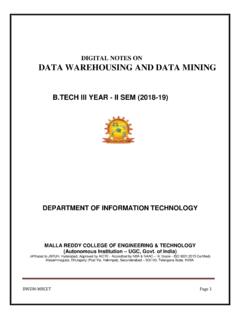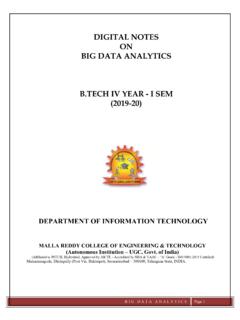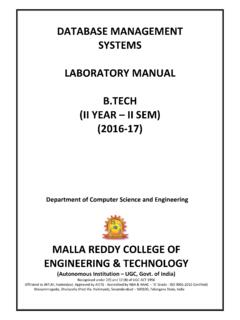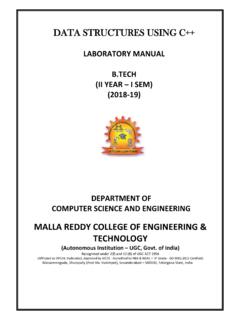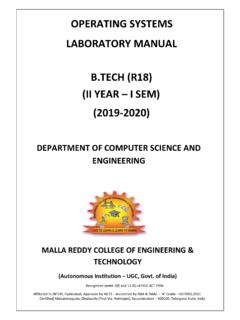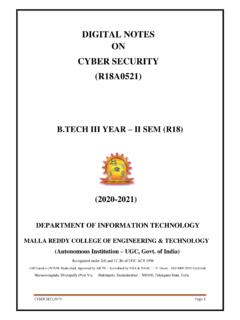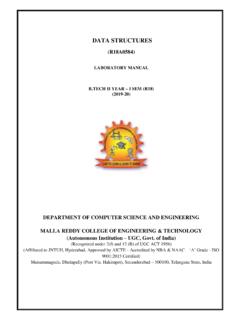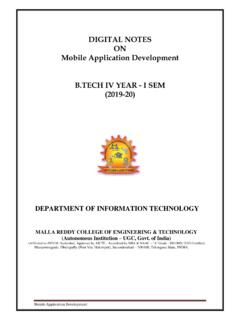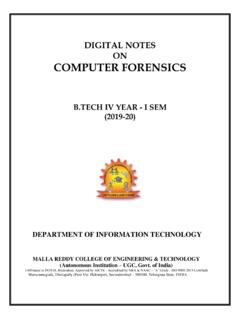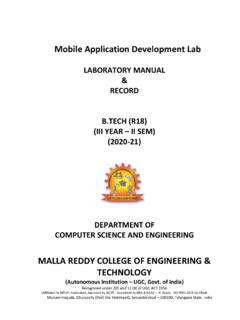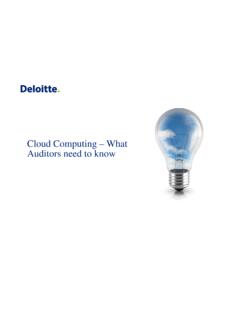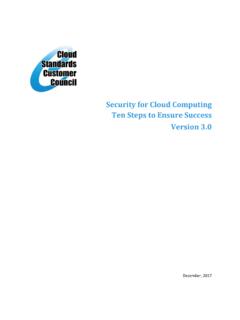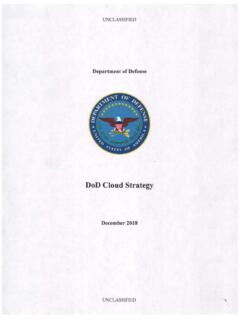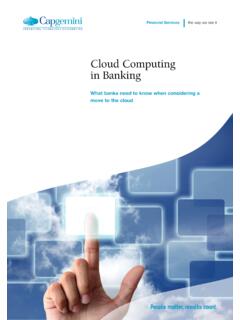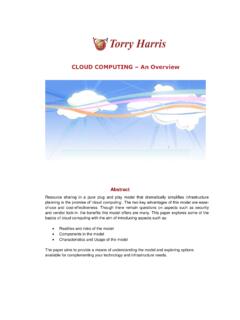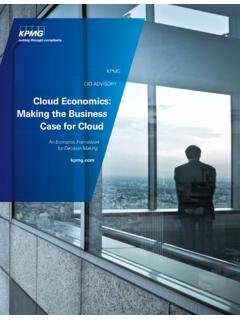Transcription of DIGITAL NOTES ON CLOUD COMPUTING - MRCET
1 CLOUD COMPUTING Page 1 DIGITAL NOTES ON CLOUD COMPUTING III YR / II SEM (2017-18) DEPARTMENT OF INFORMATION TECHNOLOGY MALLA REDDY COLLEGE OF ENGINEERING & TECHNOLOGY (Autonomous Institution UGC, Govt. of India) Recognized under 2(f) and 12 (B) of UGC ACT 1956 (Affiliated to JNTUH, Hyderabad, Approved by AICTE - Accredited by NBA & NAAC A Grade - ISO 9001:2015 Certified) Maisammaguda, Dhulapally (Post Via. Hakimpet), Secunderabad 500100, Telangana State, India CLOUD COMPUTING Page 2 MALLA REDDY COLLEGE OF ENGINEERING & TECHNOLOGY Department of Information Technology III Year IT II Sem L T/P/D C 4 / - / - 4 (R15A0529) CLOUD COMPUTING Objectives: To understand the various distributed system models and evolving COMPUTING paradigms To gain knowledge in virtualization of computer resources To realize the reasons for migrating into CLOUD To introduce the various levels of services that can be achieved by a CLOUD .
2 To describe the security aspects in CLOUD and the services offered by a CLOUD . UNIT- Systems Modeling: Distributed System Models and Enabling Technologies- Scalable COMPUTING over the Internet- System Models for Distributed and CLOUD COMPUTING - Software Environments for Distributed Systems and Clouds-- Performance, Security, and Energy Efficiency Computer Clusters for Scalable Parallel COMPUTING : Clustering- Clustering for Massive Parallelism-Computer Clusters and MPP Architectures-Design Principles of Computer Clusters-Cluster Job and Resource Management. UNIT- II Virtualization: Virtual Machines and Virtualization of Clusters and data Centers- Implementation Levels of Virtualization -Virtualization Structures/Tools and Mechanisms-Virtualization of CPU, Memory, and I/O Devices-Virtual Clusters and Resource Management-Virtualization for data - center Automation UNIT- III Foundations: Introduction to CLOUD COMPUTING - Migrating into a CLOUD -The Enterprise CLOUD COMPUTING Paradigm.
3 UNIT- IV Infrastructure as a Service (IAAS)& Platform (PAAS):Virtual machines provisioning and Migration services-On the Management of Virtual machines for CLOUD Infrastructures-Aneka Integration of Private and Public Clouds UNIT- V Software as a Service( SAAS)& data Security in the CLOUD : Google App Engine Centralizing Email Communications- Collaborating via Web-Based Communication Tools-An Introduction to the idea of data Security- The Current State of data Security in the CLOUD - CLOUD COMPUTING and data Security Risk- CLOUD COMPUTING and Identity. TEXT BOOKS: 1. Distributed and CLOUD COMPUTING , Kaittwang Geoffrey and Jack J Dongrra, Elsevier India 2012. CLOUD COMPUTING Page 3 CLOUD COMPUTING - Raj Kumar Buyya, Christian Vecchiola and , TMH, 2012. 3. Michael Miller, CLOUD COMPUTING : Web-Based Applications That Change the Way You Work and Collaborate Online, Que Publishing, August 2008.
4 Reference Books: 1. CLOUD COMPUTING : A Practical Approach, Anthony , Toby , Robert Elsenpeter, Tata McGraw Hill, rp2011. 2. Enterprise CLOUD COMPUTING , Gautam Shroff, Cambridge University Press, 2010. 3. CLOUD COMPUTING : Implementation, Management and Security, John , James , CRC Press, rp2012. 4. CLOUD Application Architectures: Building Applications and Infrastructure in the CLOUD , George Reese, O reilly, SPD, rp2011. 5. CLOUD Security and Privacy: An Enterprise Perspective on Risks and Compliance, Tim Mather, Subra Kumaraswamy, Shahed Latif, O Reilly, SPD, rp2011. Outcomes: To distinguish the different models and COMPUTING paradigms. To explain the levels of virtualization and resources virtulaization To analyze the reasons for migrating into CLOUD To effectively use the CLOUD services in terms of infrastructure and operating platforms.
5 To apply the services in the CLOUD for real world scenarios CLOUD COMPUTING Page 4 INDEX Title Page No 1 COMPUTING Paradigm & Degrees of Parallelism 5 2 The Internet of Things (IoT) & Cyber-Physical Systems 7 3 System Models For Distributed And CLOUD COMPUTING 7 4 Service-Oriented Architecture (SOA) 9 5 Performance Metrics & Energy Efficiency in Distributed COMPUTING 10 6 Clustering for Massive Parallelism 14 7 Basic Cluster Architecture 15 8 Levels of Virtualization Implementation 29 9 VMM Design Requirements and Providers 30 10 Xen Architecture 32 11 Full virtualization- CPU Memory-I/O Virtualization 32 12 CLOUD OS for Virtualized data Centers 36 13 Introduction to CLOUD COMPUTING 37 14 Introduction Migration into CLOUD 40 15 Challenges in the CLOUD 43 16 Introduction to IAAS 44 17 OVF (Open Virtualization Format) 47 18 Live Migration Effect 50 19 Aneka 52 20 SaaS 53 21 Integration Products And Platforms 53 22 Google App Engine 54 23 Centralizing Email Communications 55 24 Collaborating via Web-Based Communication Tools 56 25 An Introduction to the idea of data Security 57 26 The Current State of data Security in the CLOUD 58 27 CLOUD COMPUTING and Identity 59 28 CLOUD COMPUTING and data Security Risk 60 CLOUD COMPUTING Page 5 UNIT -1 Scalable COMPUTING over the Internet High-Throughput COMPUTING -HTC HTC paradigm pays more attention to high-flux COMPUTING .
6 The main application for high-flux COMPUTING is in Internet searches and web services by millions or more users simultaneously. The performance measures high throughput or the number of tasks completed per unit of time. HTC technology needs to improve batch processing speed, and also address the acute problems of cost, energy savings, security, and reliability at many data and enterprise COMPUTING centers COMPUTING Paradigm Distinctions Centralized COMPUTING o This is a COMPUTING paradigm by which all computer resources are centralized in one physical system. o All resources (processors, memory, and storage) are fully shared and tightly coupled within one integrated OS. o Many data centers and supercomputers are centralized systems, but they are used in parallel, distributed, and CLOUD COMPUTING applications. Parallel COMPUTING In parallel COMPUTING , all processors are either tightly coupled with centralized shared memory or loosely coupled with distributed memory.
7 Interprocessor communication is accomplished through shared memory or via message passing. A computer system capable of parallel COMPUTING is commonly known as a parallel computer Programs running in a parallel computer are called parallel programs. The process of writing parallel programs is often referred to as parallel programming Distributed COMPUTING A distributed system consists of multiple autonomous computers, each having its own private memory, communicating through a computer network. Information exchange in a distributed system is accomplished through message passing. A computer program that runs in a distributed system is known as a distributed program. The process of writing distributed programs is referred to as distributed programming. Distributed COMPUTING system uses multiple computers to solve large-scale problems over the Internet using a centralized computer to solve computational problems.
8 CLOUD COMPUTING An Internet CLOUD of resources can be either a centralized or a distributed COMPUTING system. The CLOUD applies parallel or distributed COMPUTING , or both. Clouds can be built with physical or virtualized resources over large data centers that are centralized or distributed. CLOUD COMPUTING can also be a form of utility COMPUTING or service COMPUTING CLOUD COMPUTING Page 6 Degrees of Parallelism Bit-level parallelism (BLP) : o converts bit-serial processing toword-level processing gradually. Instruction-levelparallelism (ILP) o the processor executes multiple instructions simultaneously rather thanonly one instruction at a time. o ILP is executed through pipelining, superscalarcomputing, VLIW (very long instruction word) architectures, and multithreading. o ILP requiresbranch prediction, dynamic scheduling, speculation, and compiler support to work efficiently.
9 data -level parallelism (DLP) o DLP through SIMD (single instruction, multipledata) and vector machines using vector or array types of instructions. o DLP requires even more hardwaresupport and compiler assistance to work properly. Task-level parallelism (TLP): o Ever since the introduction of multicoreprocessors and chip multiprocessors (CMPs), we have been exploring TLP o TLP is far from beingvery successful due to difficulty in programming and compilation of code for efficient execution onmulticore CMPs. Utility COMPUTING o Utility COMPUTING focuses on a business model in which customers receive COMPUTING resources from a paid service provider. All grid/ CLOUD platforms are regarded as utility service providers. The Internet of Things (IoT) o Traditional Internet connects machines to machines or web pages to web pages. o IoT was introduced in 1999 at MIT o networked interconnection of everyday objects, tools, devices, or computers o a wireless network of sensors that interconnect all things in our daily life.
10 O Three communication patterns co-exist: namely H2H (human-to-human), H2T (human-tothing),and T2T (thing-to-thing). o connect things (including human and machine objects) at any time and any place intelligently with low cost o IPv6 protocol, 2128 IP addresses are available to distinguish all the objects on Earth, including all computers and pervasive devices o IoT needs to be designed to track 100 trillion static or moving objects simultaneously. o IoT demands universal addressability of all of the objects or things. o The dynamic connections will grow exponentially into a new dynamic network of networks, called the Internet of Things (IoT). Cyber-Physical Systems o A cyber-physical system (CPS) is the result of interaction between computational processes and the physical world. o CPS integrates cyber (heterogeneous, asynchronous) with physical (concurrent and information-dense) objects CLOUD COMPUTING Page 7 o CPS merges the 3C technologies of computation, communication, and control into an intelligent closed feedback system o IoT emphasizes various networking connections among physical objects, while the CPS emphasizes exploration of virtual reality (VR) applications in the physical world SYSTEM MODELS FOR DISTRIBUTED AND CLOUD COMPUTING o Distributed and CLOUD COMPUTING systems are built over a large number of autonomous computer nodes.
